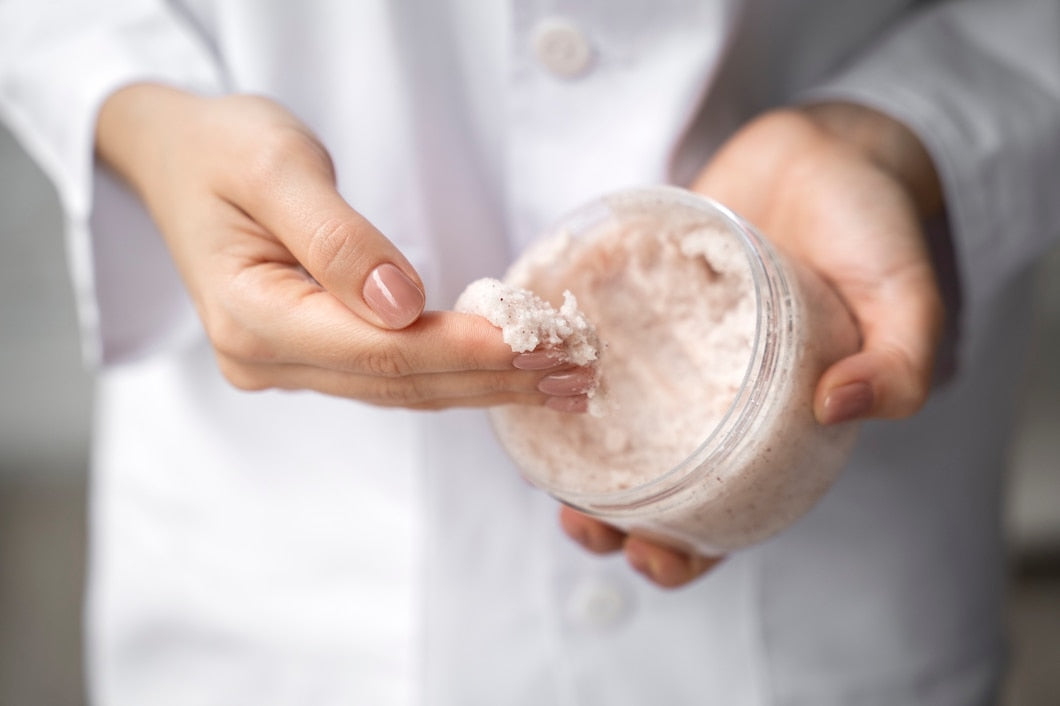
Chemical vs. Physical Exfoliants – Which One Should You Choose for Your Skin?
Exfoliation is one of the most important steps in any skincare routine. It helps slough off dead skin cells, unclogs pores, and reveals a brighter, smoother complexion. But with so many products available, one question often comes up: Should you go for chemical exfoliants or physical exfoliants?
Both have unique benefits, and the right choice depends on your skin type and concerns. In this guide, we’ll break down the difference between chemical and physical exfoliation, the pros and cons of each, and tips for choosing the best option for your skin.
What is Exfoliation?
Exfoliation is the process of removing dead skin cells from the surface of your skin. Our skin naturally sheds cells, but sometimes this process slows down, leading to dullness, clogged pores, breakouts, and uneven texture. Exfoliants help speed things up—leaving your skin fresher and healthier.
Physical Exfoliants
Physical exfoliants involve manually scrubbing away dead skin cells using tiny granules, brushes, or tools.
Examples include:
-
Scrubs with sugar, salt, or coffee grounds
-
Brushes or silicone cleansing tools
-
Exfoliating gloves or sponges
Benefits of Physical Exfoliants:
-
Instant smoothness and glow
-
Easy to use and widely available
-
Great for areas with rough skin (like elbows, knees, feet)
Drawbacks:
-
Can be too harsh if overused
-
Risk of micro-tears in the skin
-
Not always suitable for sensitive or acne-prone skin
Chemical Exfoliants
Chemical exfoliants use acids or enzymes to dissolve dead skin cells, rather than scrubbing them away.

Common types include:
-
AHAs (Alpha Hydroxy Acids): Glycolic acid, lactic acid – best for dry, dull skin.
-
BHAs (Beta Hydroxy Acids): Salicylic acid – ideal for oily and acne-prone skin.
-
PHAs (Polyhydroxy Acids): Gentler acids, suitable for sensitive skin.
-
Enzyme exfoliants: Derived from fruits like papaya or pineapple.
Benefits of Chemical Exfoliants:
-
More precise and even exfoliation
-
Can target deeper skin concerns (like acne, pigmentation, fine lines)
-
Gentler options available for sensitive skin
-
Improves skin texture over time
Drawbacks:
-
Requires consistency and patience
-
Can cause irritation if overused
-
Sun sensitivity may increase (SPF is a must!)
Which One Should You Choose?
✅ Choose Physical Exfoliants if:
-
You want immediate smoothness and glow
-
Your skin is not overly sensitive
-
You’re exfoliating rough areas (body scrubs, feet, elbows)
✅ Choose Chemical Exfoliants if:
-
You have acne-prone, oily, or dull skin
-
You want anti-aging benefits (reducing fine lines, pigmentation)
-
Your skin reacts badly to scrubs
Can You Use Both?
Yes—but with caution! Many people benefit from combining both types of exfoliation. For example:
-
Use a gentle chemical exfoliant weekly for overall skin renewal.
-
Use a mild physical exfoliant once in a while for an instant refresh.
The key is moderation—over-exfoliation can damage your skin barrier.
Tips for Safe Exfoliation
-
Start slow – 1–2 times a week is enough.
-
Always moisturize after exfoliating – to prevent dryness.
-
Never skip sunscreen – exfoliation makes skin more sensitive to the sun.
-
Patch test chemical exfoliants before full application.
-
Avoid harsh scrubs if you have acne, rosacea, or sensitive skin.
Conclusion
Both chemical and physical exfoliants have their place in skincare. Physical exfoliants are great for quick results and body care, while chemical exfoliants offer deeper, more long-term benefits for skin health. The best choice depends on your skin type, lifestyle, and tolerance.
When in doubt—start gently, listen to your skin, and consult a dermatologist if you’re unsure.